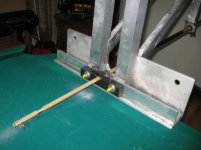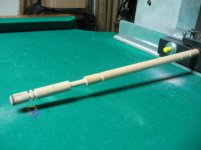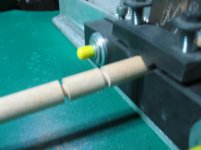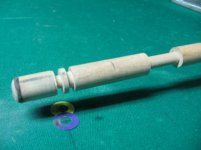purchasing
Duckie
While I agree with your statement that speed control is a big factor in cue success, I disagree with your generalizations of why people purchase LD shafts.
I do not buy LD shafts (and I do know that they should be called Low Squirt shafts) for the speed control.
I buy a range of products and try them out and resell the ones I don't like and use the ones I do like.
Someone looking for a new cue may buy based upon reseller recommendations or they may buy on feel/happiness alone. Neither option is wrong, but neither option is guaranteed to get them the best performing system.
Someone wanting to buy a snowplow for their pickup needs to evaluate their anticipated use. If they are going to move snow alot, they probably should buy a boss v plow for $9,000 if they can afford it. Someone planning to move snow on their residential driveway may want to buy a $1,500.00 sears home plow. It would be difficult and pointless for me or you to critique their purchase.
I do laugh when I see people decked out in the best ski gear that can barely ride the chairlift, but they put the amount of money into their ski activities as they wanted to and they are happy. A regular skier may benefit from an equipment upgrade if they are using the old thin skis. Technology in skis changed. If you want to ski around in old thin skis, nobody is stopping you. Does anybody need to know why they ski better on the new wide skis? Probably not. Are the new skis so good that you can drink coffee and read the paper while you ski? No.
While I may be the exception to the rule, I prefer to try many different brands and styles and make my own choice. I have the money to do this. Many of my friends buy one cue and never think twice about their cue selection, and many think and wonder if there is something better out there. Is there a cue out there that solves all of the world's problems? No. However, my Capone cue with OB Classic shaft is as close to perfect as I've seen. I can tell you that the OB Classic plays completely different than my standard Capone shafts. Same stroke, same hit style, same rythym, different result. I could play decent with either one, but the OB Classic is what I'm used to and what feels right.
Golf and billiards are two sports where you can work with an old system (house cues and old steel shafts/driver heads come to mind) or advanced engineered systems (I hit my first 300 yard drive with a taylormade R7 and I would not have sold that driver for any amount of money at the time, but now I wonder if the bowling ball size driver heads out now are better. Now I don't golf enough due to back problems to care. I continue to shoot decent pool with my high performance cues and shafts and I'm happy.
I'm interested in the physics enough to buy a barioni tuned shaft on a new cue. I am not doing it because I think it will straigten out my elbow or perfect my stroke speed, I'm interested because it may be a better idea. It could fail miserably or be cue bliss. Either way, I'm not going to tell someone they need to use a barioni cue to hit better. I will however tell them why I purchased the cue and let them try for themselves.
Some people like to stick with their old skinny skis, and some like to venture out and see what the world has to offer. I have no problem with either type of person. I'm not saying that LS shafts are the fat skis of the billiard world, but they are an engineered system that is designed to perform better than wood.
I'm a building contractor that understands the performance of my building systems. You can build a house with standard 2x6 lumber, but it will not be as straight or strong (generalizing and simplifying here) as manufactured wood or steel studs. Will I build you a building with 2x6 lumber? Sure. Would it be better if built with other materials? Sure. Manufactured lumber and manufactured shafts are very similar. They are both built better than most natural shapes.
I believe it is wrong to generalize cue buyers based upon one guy you know. Many may be intelligent shoppers. I also disagree with people that bash other ideas and systems based on their own biased points of view.
I'll stop now.
There is a difference between product testing and scientific testing.
This is product testing in that all it shows is the difference's in performance of the different cues under the same test parameters. Product testing does not always reflect actual real world operating conditions. Such is the case in this testing.
Scientific testing would take into consideration all the variables that are encountered in the real world of shot making and not just one set of testing parameters.
Doing test at only one speed does not reflect what happens at various speeds that is used in shot making. In 14.1, slow rolls are key, yet, the testing here does not include these slow rolls.
What about bridge length? The distance from the bridge pivot and the cue ball. In this test, the same length is used unlike in the real world of shot making where the same bridge length can not always be used.
The result of this marketing is a person will buy a LD shaft thinking they need one, when in reality, they are just shooting too hard, are trying to do too much on a shot with a cue ball.
I've been playing a new player that got a LD shaft cue and is so proud of it. He can talk the lingo, but he is clueless about the real facts behind shot making. Instead of understanding the ins and outs of shot making, he bought into the hype of needing a LD shaft because of per marketing.
I find the biggest weakness of players is lack of knowing just how much speed is needed to do a shot. I notice most shoot harder than needed for the shot or not understanding how to make the CB work for you. So, they get a LD shaft thinking that's the answer and it might be for a short time only. No matter what shaft you use,until you master your speed control, you will only go so far.
And the only way to master speed control is table time and not equipment used.
Most on here will never get the level of feel needed to truly know what is going on between the CB and cue tip.




